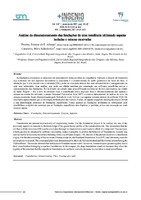A análise do dimensionamento das fundações de uma residência utilizando sapatas isoladas e estacas escavadas
Date
2021-09-04Author
Pereira, Afonso Simone de Fatima
Casanova Sokolovicz, Bóris
Metadata
Show full item recordAbstract
As fundações encontram-se presentes em praticamente todas as obras de engenharia. Para que o projeto de fundações seja realizado um dos aspectos necessários a considerar é o conhecimento do perfil geotécnico do local da obra. A interação que o solo possui com a estrutura (ISE), pode ser simulada através das suas características e carregamentos ao qual está submetido. Esta análise, que pode ser obtida também por simulação em software, possibilita prever o comportamento das fundações. Foi realizado um estudo para uma edificação residencial de dois pavimentos, na cidade de Santo ngelo – RS, o solo do presente local é classificado como argiloso. Para o dimensionamento das sapatas e estacas escavadas foi utilizado o ensaio Standard Penetration Test (SPT) e ensaios laboratoriais de análise de solo. As estacas escavadas foram dimensionadas pelo Método de Aoki Velloso e as sapatas isoladas através do software TQS. Os resultados apresentaram que os dois tipos de fundações são viáveis. Porém, as sapatas requerem uma rigidez maior devido a sua classificação pertencer às fundações superficiais. Nesse aspecto as fundações profundas se sobressaem pois possibilitam a rigidez da estrutura que as fundações superficiais não dispõem, e também, pela a sua execução ser mais simples rápida. Foundations are present in practically all engineering works. For the foundation project to be carried out, one of the necessary aspects to consider is the knowledge of the geotechnical profile of the construction site. The interaction that the soil has with the structure (ISE) can be simulated through its characteristics and loads to which it is subjected. This analysis, which can also be obtained by software simulation, makes it possible to predict the behavior of foundations. A study was carried out for a two-story residential building in the city of Santo ngelo - RS, the soil of the present location is classified as clayey. For the dimensioning of the excavated footers and piles, the Standard Penetration Test (SPT) and laboratory tests for soil analysis were used. The excavated piles were dimensioned by the Aoki Velloso Method and the footers isolated using the TQS software. The results showed that both types of foundations are viable. However, footers require greater rigidity due to their classification belonging to surface foundations. In this respect, the deep foundations stand out because they allow the rigidity of the structure that the superficial foundations do not have, and also, because its execution is simpler and faster.
URI
info:eu-repo/semantics/altIdentifier/url/https://revistas.fio.unam.edu.ar/index.php/masingenio/article/view/265/685https://hdl.handle.net/20.500.12219/3288
Collections
- Revista +INGENIO [65]
The following license files are associated with this item:




